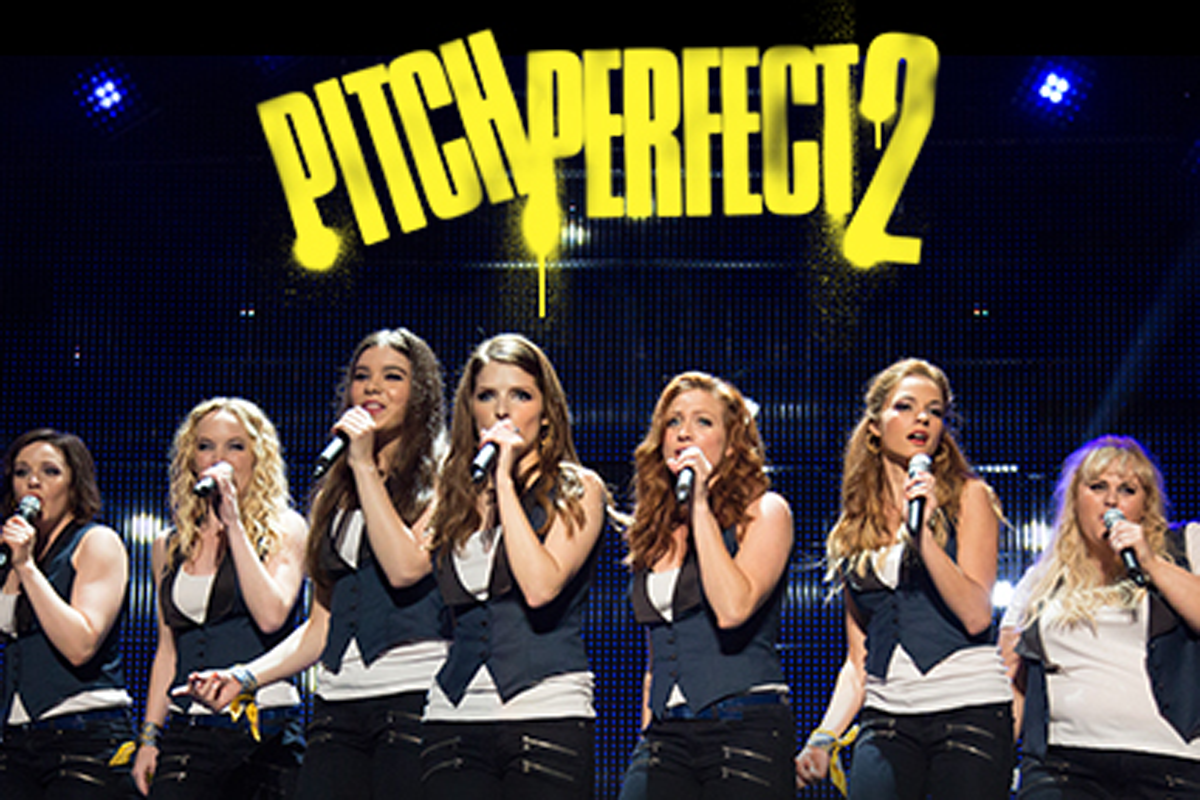Pitch Perfect 2
Posted on May 14, 2015 at 5:48 pm
B+| Lowest Recommended Age: | High School |
| MPAA Rating: | Rated PG-13 for innuendo and language |
| Profanity: | Some strong and crude language |
| Alcohol/ Drugs: | Drinking |
| Violence/ Scariness: | Comic peril and violence, no one hurt |
| Diversity Issues: | Diverse characters |
| Date Released to Theaters: | May 15, 2015 |
| Date Released to DVD: | September 21, 2015 |
| Amazon.com ASIN: | B00NYC3SG4 |

“Pitch Perfect 2” is — bear with me — the musical comedy variation on the “Furious 7” recipe for success. The sequel jettisons any pretense of seriousness of purpose, structural logic, or psychological authenticity, joyfully tosses off any pretense of taking itself, its heartwarmingly diverse characters, or its storyline seriously. And both, unexpectedly but utterly deservedly, will make you teary-eyed. Substitute exquisitely harmonized snippets of popular songs for cars flying out of planes, and it’s basically the same movie. And there’s nothing wrong with that. “Pitch Perfect 2” is even more fun than the first.
Beca (Anna Kendrick) was just starting college in the first film, about her reluctant agreement to join the all-girl acapella group called The Barden Bellas, led by Aubrey (Anna Camp) and her loyal lieutenant Chloe (Brittany Snow). Now Aubrey has graduated but Chloe is still there, deliberately flunking so she will not have to leave the now-three-time national champion Bellas. Beca is a senior, hoping she can take on a dream internship with a musical producer (Keegan-Michael Key, the “angry Obama”) without disrupting the group.
But the group has been disrupted. The Bellas performed at the President’s birthday celebration (footage of the Obamas is inserted to make it look like they were really there), with Fat Amy (Rebel Wilson) coming in like a wrecking ball on a trapeze. It was a triumph until it became a disaster when Fat Amy’s skin-tight jumpsuit split open and she wasn’t wearing underwear.
The Bellas are banned from collegiate competition, and are not even allowed to conduct auditions. Too bad for those hoping for a reprise of one of the first film’s most entertaining scenes, but there is simply no time. We hardly get a chance to hear Barden’s male acapella group, the Treblemakers, either. This is all about the Bellas fighting their way back with the only option left to them — an international competition, up against the world champions, Germany’s Das Sound Machine, a group so terrifyingly huge and technically perfect it is a kind of acapella Triumph of the Will.
But we’re not here for the plot; we’re here for the music, and there is a ton of it, all so good and so varied that it is frustrating to get it in such short snippets. Songs made popular by the Andrews Sisters, Hansen, Taylor Swift, En Vogue, Mika, Montell Jordan, and Carrie Underwood zip by, most hilariously in a sing-off that tops the original’s. Categories include “Songs About Butts” (one character points out that’s pretty much everything on the radio) and “I Dated John Mayer.” Hilariously, one of the competing acapella groups is the Green Bay Packers. And Snoop Dogg shows up to sing a Christmas song.
There is one new addition to the Bellas, though, “True Grit’s” Hailee Steinfeld as Emily, an eager but shy freshman whose mom (Katey Sagal) was a Bella, so she’s a legacy. She also writes songs.
Will the Bellas get their mojo back? Will Beca impress her boss? Will Aubrey show up for a pep talk? Will there be some delicious silliness along the way? Will Emily’s new songs be game-changers when the long-standing tradition is covers only? How about some romance (a bit) and some comedy (a lot)? But what’s the deal with the false eyelashes on everyone? Did Elizabeth Banks bring on her Effie Trinket makeup team? Fat Amy’s no/yes from Fat Amy when Bumper (Adam Devine of “Modern Family”) says he wants to have sex with her is ooky and just plain off.
But first time director Banks, who co-produced the first film and the sequel, and returns, this time as both commentator on acapella competitions and as head of the organization, manages a very large cast and an even larger set list. She keeps the tone light and breezy, balancing the outrageous (hate mail from Supreme Court Justice Sonia Sotomayor?) with the touching. A call-back to the first film’s breakout hit “Cups,” is simply lovely. If some elements of what we can barely dignify by terming a storyline are pat and predictable, the song choices are not. From the very first moment, with an a capella rendition of the Universal” logo music, we are in mash-up heaven. It is worth the price of admission to hear “MmmBop” acapella, and then, icing on the cake and cherry on the sundae, we get some Kris Kross “Jump” action as well. Acca-heaven.
Parents should know that this film includes some crude sexual and bodily function humor, some strong language, and comic violence (no one hurt). There is a joke that seems to imply that a woman’s “no” to an invitation to have sex is not to be taken seriously, but it later turns out that this is part of a consensual relationship.
Family discussion: What makes you special? What makes your friends and family special? How do you find your voice to express who you are?
If you like this, try: the first “Pitch Perfect” and the television show “The Sing-Off”


